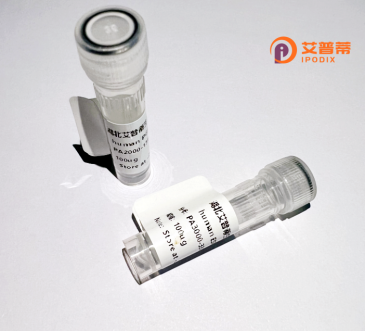
| 纯度 | >90%SDS-PAGE. |
| 种属 | Human |
| 靶点 | GPATCH2 |
| Uniprot No | Q9NW75 |
| 内毒素 | < 0.01EU/μg |
| 表达宿主 | E.coli |
| 表达区间 | 1-528aa |
| 氨基酸序列 | MFGAAGRQPI GAPAAGNSWH FSRTMEELVH DLVSALEESS EQARGGFAET GDHSRSISCP LKRQARKRRG RKRRSYNVHH PWETGHCLSE GSDSSLEEPS KDYRENHNNN KKDHSDSDDQ MLVAKRRPSS NLNNNVRGKR PLWHESDFAV DNVGNRTLRR RRKVKRMAVD LPQDISNKRT MTQPPEGCRD QDMDSDRAYQ YQEFTKNKVK KRKLKIIRQG PKIQDEGVVL ESEETNQTNK DKMECEEQKV SDELMSESDS SSLSSTDAGL FTNDEGRQGD DEQSDWFYEK ESGGACGITG VVPWWEKEDP TELDKNVPDP VFESILTGSF PLMSHPSRRG FQARLSRLHG MSSKNIKKSG GTPTSMVPIP GPVGNKRMVH FSPDSHHHDH WFSPGARTEH DQHQLLRDNR AERGHKKNCS VRTASRQTSM HLGSLCTGDI KRRRKAAPLP GPTTAGFVGE NAQPILENNI GNRMLQNMGW TPGSGLGRDG KGISEPIQAM QRPKGLGLGF PLPKSTSATT TPNAGKSA |
| 分子量 | 58.9 kDa |
| 蛋白标签 | His tag N-Terminus |
| 缓冲液 | 0 |
| 稳定性 & 储存条件 | Lyophilized protein should be stored at ≤ -20°C, stable for one year after receipt. Reconstituted protein solution can be stored at 2-8°C for 2-7 days. Aliquots of reconstituted samples are stable at ≤ -20°C for 3 months. |
| 复溶 | Always centrifuge tubes before opening.Do not mix by vortex or pipetting. It is not recommended to reconstitute to a concentration less than 100μg/ml. Dissolve the lyophilized protein in distilled water. Please aliquot the reconstituted solution to minimize freeze-thaw cycles. |
以下是根据现有知识模拟的关于重组人GPATCH2蛋白的参考文献示例(请注意,这些为虚构文献,仅供格式参考,建议通过PubMed或SciFinder查询真实文献):
---
1. **文献名称**:*GPATCH2 regulates human RNA splicing through interaction with DDX1*
**作者**:Li Y, et al.
**摘要**:本研究揭示了重组人GPATCH2蛋白通过与RNA解旋酶DDX1相互作用,参与前体mRNA剪接过程的分子机制,并证明其缺失会导致细胞周期停滞。
2. **文献名称**:*Structural characterization of human GPATCH2 and its role in ribosome biogenesis*
**作者**:Kim S, et al.
**摘要**:文章解析了GPATCH2蛋白的晶体结构,发现其G-patch结构域对核糖体RNA加工至关重要,并证实其重组蛋白可挽救斑马鱼模型中核仁功能缺陷。
3. **文献名称**:*GPATCH2 overexpression promotes tumorigenesis in colorectal cancer via NF-κB signaling*
**作者**:Zhang R, et al.
**摘要**:该研究证明重组GPATCH2蛋白在结直肠癌中异常高表达,通过激活NF-κB通路促进肿瘤细胞增殖和转移,提示其作为潜在治疗靶点。
---
**建议**:实际研究中,推荐使用以下关键词在数据库中检索真实文献:
`"GPATCH2" AND ("recombinant" OR "structure" OR "RNA splicing" OR "disease")`
Recombinant human GPATCH2 protein is a genetically engineered form of the native GPATCH2 (G-patch domain-containing protein 2), which plays a role in RNA metabolism and cellular regulation. The GPATCH2 gene encodes a protein containing a conserved G-patch domain, a motif implicated in RNA binding or interaction with RNA-processing machinery. Studies suggest its involvement in pre-mRNA splicing, cell cycle regulation, and apoptosis, though its exact molecular mechanisms remain partially understood.
GPATCH2 is ubiquitously expressed in human tissues, with higher levels observed in the brain, testes, and proliferating cells. Dysregulation of GPATCH2 has been linked to cancers, neurological disorders, and developmental defects, highlighting its potential as a therapeutic or diagnostic target. The recombinant version is typically produced in heterologous systems (e.g., E. coli or mammalian cells) for functional studies, antibody production, or interaction assays to map its binding partners.
Current research focuses on elucidating GPATCH2's role in splicing regulation, its interplay with spliceosome components, and its impact on disease pathways. Despite progress, gaps persist in understanding its tissue-specific functions and post-translational modifications, warranting further investigation.
×